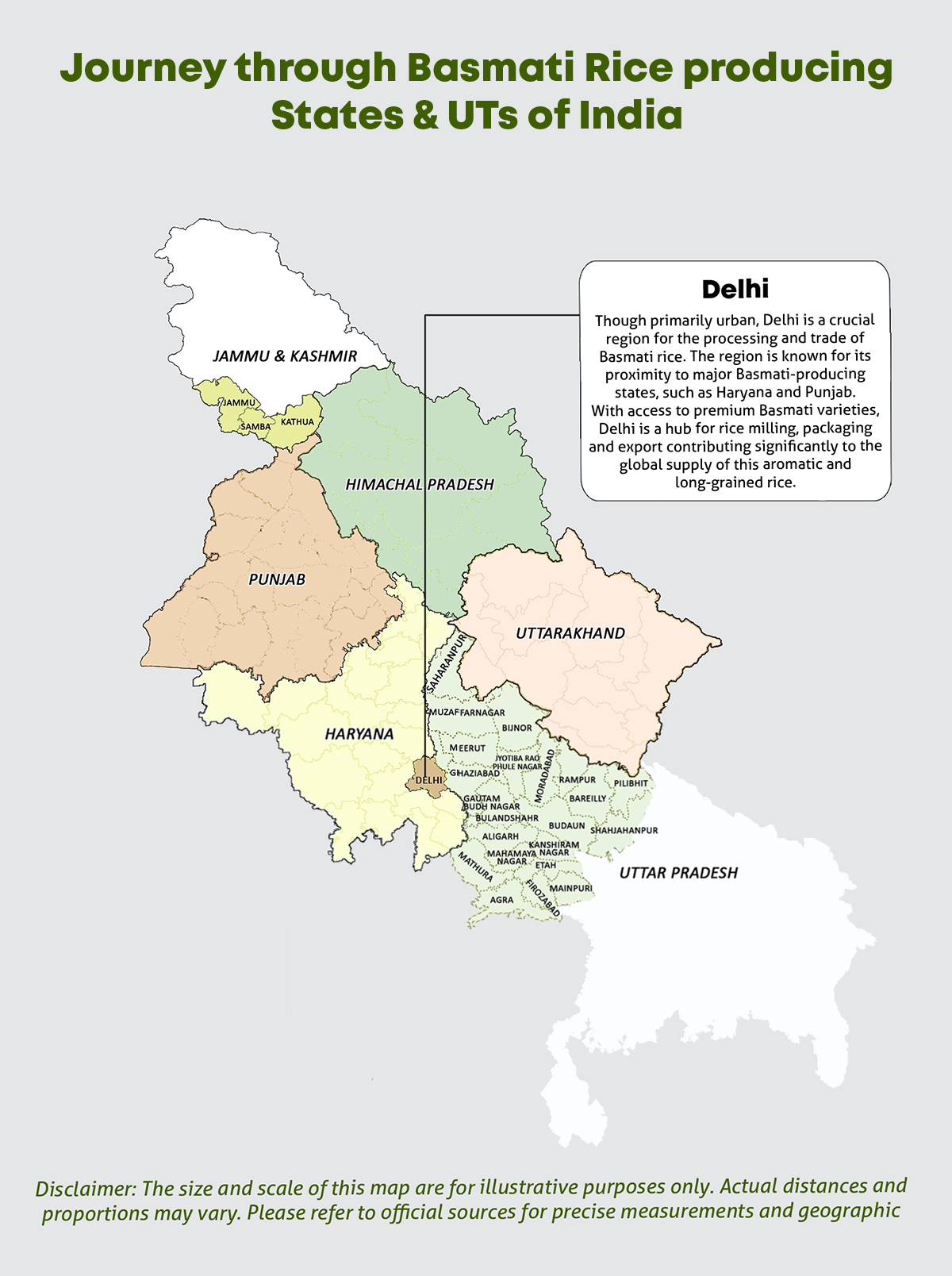

The finest Basmati Rice is celebrated globally for its exquisite taste, superior aroma, and unparalleled quality. As the leading exporter of Basmati rice, India has perfected the art of cultivating and processing this Basmati, making it a staple in cuisines around the world. Basmati rice stands out with its extra-long, slender grains that expand to twice their original size when cooked, offering a unique soft and fluffy texture.Know More
Grown in India, loved by the world
Export Volume
and Value
India exported 5.24 MMT of Basmati rice in the fiscal year 2023-24, valued at approximately USD 5.84 Billion.
Export
Growth
Basmati rice exports from India increased by 21.9% in the fiscal year 2023-24.
Leading Export
Destinations
Leading export destinations for Basmati rice include Saudi Arabia, Iraq, Iran, UAE, USA and the Gulf countries.
Variety Diversity
There are 45 varieties of Basmati rice notified under the Seeds Act, 1966. These varieties include traditional types like Basmati 370 and Taraori Basmati, as well as modern hybrids such as Pusa Basmati 1121 and Pusa Basmati 1509.
Production Regions
Basmati rice-producing states include Punjab, Haryana, Delhi, Himachal Pradesh, Uttarakhand, three districts of J&K, and 30 districts of Uttar Pradesh.
Journey through Basmati Rice producing
States & UTs of India

Jammu & Kashmir
Jammu & Kashmir
The J&K region is particularly known for Ranbir Basmati, distinguished by its unique aroma and long grain. Fertile plains, organic farming practices, and government support enhance its distinct Basmati rice production.
Himachal Pradesh
Himachal Pradesh
Himachal Pradesh cultivates Basmati rice in its lower hill regions. The state is known for its high-altitude cultivation which adds distinctiveness to the rice. Himachal's clean environment & traditional agricultural methods contribute to its Basmati rice cultivation.
Uttarakhand
Uttarakhand
Known for its traditional Dehraduni Basmati, Uttarakhand's hilly terrain and specific climatic conditions impart a unique flavour and aroma to the rice. The state's commitment to organic farming practices enhances the appeal of its Basmati rice.
Punjab
Punjab
Punjab is one of the leading states in Basmati rice production, known for its fertile soil and favourable climatic conditions. It produces high-quality Basmati varieties like Pusa Basmati 1121 and Punjab Basmati 3. The state's extensive irrigation network and modern farming techniques contribute significantly to the high yield and quality of Basmati rice.
Delhi
Delhi
Though primarily urban, Delhi is a crucial region for the processing and trade of Basmati rice. The region is known for its proximity to major Basmati-producing states, such as Haryana and Punjab. With access to premium Basmati varieties, Delhi is a hub for rice milling, packaging and export contributing significantly to the global supply of this aromatic and long-grained rice.
Haryana
Haryana
Haryana is a prominent Basmati rice producer, particularly known for varieties such as Haryana Basmati 1, Pusa Basmati 1509 and Pusa Basmati 1121. The state's emphasis on agricultural research and development has improved crop quality and yield.
Uttar Pradesh
Uttar Pradesh
Uttar Pradesh's 30 districts, including Saharanpur, Muzaffarnagar, Meerut, Bareilly, Pilibhit, and Aligarh, are major producers of Basmati rice. Known for varieties like Pusa Basmati 1121 and traditional types, these regions benefit from fertile Indo-Gangetic plains, extensive irrigation, and modern farming techniques, enhancing both quality and yield.
Disclaimer: The size and scale of this map are for illustrative purposes only. Actual distances and proportions may vary. Please refer to official sources for precise measurements and geographic details.
Know your Basmati Rice!

Traditional Basmati
The traditional Basmati varieties like Basmati 370 and Taraori Basmati are celebrated for their long, slender grains and rich aroma. They offer a delightful, nutty flavour and are often aged to enhance their distinct characteristics. They are a good source of carbohydrates, fiber and essential vitamins.Know More

Pusa Basmati 1121
This modern hybrid is famous for its extra-long grains that elongate significantly upon cooking. It is highly prized for its exceptional fragrance and delicate texture, making it a favourite in gourmet cooking. It is also noted for its lower glycemic index compared to other rice varieties, also making it a healthier choice.Know More

Pusa Basmati 1509
This Basmati variety is known for its quick cooking time and softer texture. Its long, slender grains and enticing aroma make it ideal for a variety of dishes, from biryanis to pilafs. It is rich in amylose, which contributes to its non-sticky texture.Know More

Mahi Sugandha and Kasturi
These varieties, often referred to as "Perfumed Rice," are known for their distinctive, strong aroma and flavour. They offer a higher yield and shorter maturation period, making them popular among farmers. Nutritionally, they provide essential minerals like magnesium and potassium.Know More

Type 3 -Dehraduni Basmati
Dehraduni Basmati, also known as Type 3 Basmati, is celebrated worldwide for its exceptional size, aroma and flavour. This variety takes its name from the city of Dehradun and is cultivated in the highlands of the Kumaon Valley in Uttarakhand.Know More

























